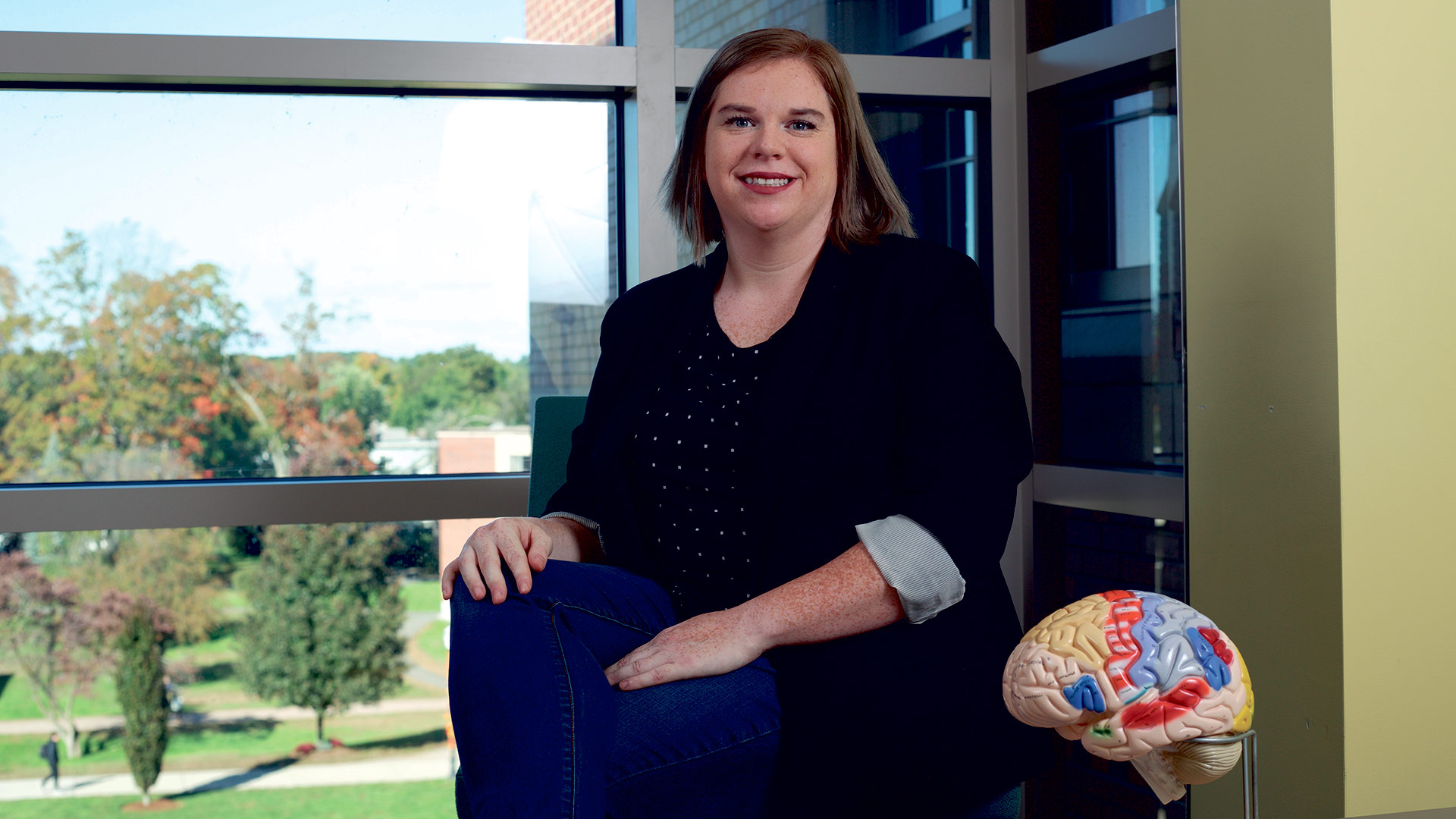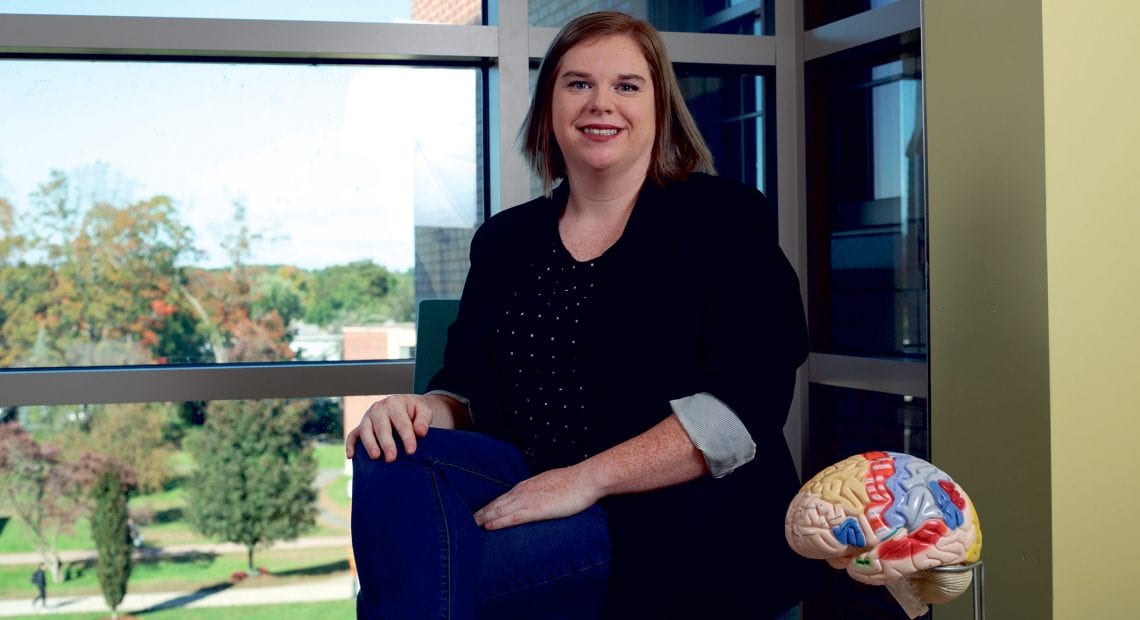Progressive Course

Laura Hanratty says the number of BCBA students has probably doubled since 2012, a clear sign of growing need for such trained individuals.
In many cases, Alyssa Clark says, progress — in whatever way it is measured — comes slowly.
But in most all cases, it does come, and when it does, it quickly reminds her why she chose this career path — not that she ever really forgets.
Clark was talking about her work as a board-certified behavior analyst, or BCBA, as those with the requisite credentials are called. She works in a few area elementary schools with students in grades K-4. Some are on the autism spectrum, but all of them are defined with an industry term of sorts: social/emotional, which means they have behavioral issues, usually brought on by trauma in their backgrounds — poverty, divorce, or being in foster care, for example.
“Sometimes, progress is slow in coming, but even the little things you see … kids might have that one good day after several bad ones,” she told BusinessWest. “And to be able to see that and know that you could make a difference in that kid’s life and help them…”
She didn’t actually finish the sentence, because she didn’t have to. The satisfaction that comes with such work is clearly apparent. And it is one of many reasons why applied behavior analysis (ABA) is becoming an increasingly popular career path within the broad spectrum of healthcare, and also why programs such as the master’s in ABA program at Elms College in Chicopee, which Clark graduated from recently, were created and continue to see growth in enrollment.
“Every kid that we work with should go through an analysis to determine why problem behaviors are occurring, and then treatment based on that analysis helps address those behavioral concerns.”
But the biggest factor is growing need within the community, said Laura Hanratty, assistant professor and director of both the ABA and ASD (autism spectrum disorders) programs at Elms.
“It’s definitely a growing field,” she said, noting that, when she sat for the certification exam in 2012, there were roughly 10,000 BCBAs in this country; now, there are perhaps twice that number.
Why? The ever-growing number of people diagnosed with autism is a big factor, she said, adding that there are many theories surrounding this surge, but the prevailing one is that there is simply more awareness of the condition and, therefore, more early diagnosis.
But the nature of applied behavior analysis, and the tremendous rewards, as Clark described, are also a factor in the growing popularity of this profession.
When asked to elaborate, Hanratty said there is a good deal of science, some of it rigid in nature, in this field. But there are also large amounts of creativity, and this blend of ingredients appeals to many people looking to enter the broad realm of healthcare.
“What we try to teach our students to do is become a scientist practitioner,” she went on, adding that there is much that goes into that phrase. “Every kid that we work with should go through an analysis to determine why problem behaviors are occurring, and then treatment based on that analysis helps address those behavioral concerns.
“We know that attention and rewards help increase behaviors,” she went on. “So what our students do is take that science side, but then then get really creative and personalize with our kids.”
This ability to be creative is what appeals to Rachel Reyes, currently enrolled in the Elms master’s degree program and working part-time with young people through a company called Positive Behavior Supports Corp. (PBS). She has one client, a 4-year-old with autism she sees three times a week.
“I’m working one-on-one with a child a lot, and that’s what I love most about this work,” she said, adding that she aspires to become a BCBA. “I get to see them grow, I get to see their progress, and I get to know them; I build a relationship with them first so they they’ll trust me.”
For this issue and its focus on healthcare, BusinessWest takes an in-depth look at the ABA offering at Elms. In the course of doing so, we’ll explain why the program, and the careers it can lead to, have attracted people like Clark, Reyes, and many others.
Down to a Science
When asked how she got onto the path to becoming a BCBA, Clark said a single course on applied behavior analysis she was taking during her undergraduate work at the Elms opened her eyes and changed her career focus.

Alyssa Clark, seen here at the Applied Behavior Analysis International Conference in San Diego earlier this year, says there are many rewards from her work as a BCBA.
“I was in the speech language pathology program,” she recalled. “They mentioned applied behavior analysis; that one class really stuck with me. I knew I always wanted to work with this population of kids, whether it was kids on the autism spectrum or kids with disabilities. So I looked into it more and I saw the behavior side of things, and I loved it.”
Reyes tells a somewhat similar story. She was doing undergraduate work at Westfield State University, studying special education. She had come to the conclusion that she didn’t want to teach and took an introductory course in ABA.
“Prior to creation of this program, there was a master’s in autism spectrum disorders, which was also behavior-analytics-focused, but a little more broad. What we found is that most people who are coming into the program are really interested in the behavior-analysis side, so that’s where most of our students are now.”
“The professor was great — when she would teach, everything was amazing,” she recalled. “I thought about things some more, went to her office, and asked if there were any graduate programs in the field, because I realized that this is what I wanted to do. She told me about Elms.”
Hanratty said many of the students now in the ABA program arrive via a somewhat similar experience, and this helps explain the creation of the master’s program, which accepted its first cohort in 2017.
“Prior to creation of this program, there was a master’s in autism spectrum disorders, which was also behavior-analytics-focused, but a little more broad,” she explained. “What we found is that most people who are coming into the program are really interested in the behavior-analysis side, so that’s where most of our students are now.”
Students enter the program with a wide diversity of backgrounds, she went on, adding that there are many with a psychology or communications sciences background, who took their undergraduate focus on speech disorders and shifted it to behavioral analysis.
But there are others with backgrounds in education, sociology, social work, and other fields.
“We also get some students who earned their bachelor’s degree in … whatever, and then found a passion for working with kids with autism,” she went on, adding that enrollment in the master’s program fluctuates, but it averages about 17. The smaller size of the cohorts — and the classes themselves — appeal to many students because of the one-to-one support from faculty members.
As she mentioned earlier, ABA is a blend of science and creativity that addresses a range of recognized behavioral issues in people of all ages.
“ABA is based on basic science principles,” Hanratty explained. “We take the basic principles of behavior and apply them to promote changes in behavior among children with autism or behavior concerns. Our students get to take that science and apply it.”
Practitioners use reinforcement — giving some kind or reward or positive contingency — for appropriate behaviors, as well as strategies for reducing inappropriate behaviors.
When asked for an example, she cited a research project she worked on with several of her students, including Clark. Together, they gave a presentation on their work at the Applied Behavior Analysis International Conference in San Diego earlier this year, and also at the Berkshire Conference for Behavioral Analysis.
The project involved one young person exhibiting problem behaviors, said Hanratty. “We did an analysis and found that kids were engaging in severe problem behavior usually to gain some control over their environment — they want to take a break from adult-led activities and just have time to do their preferred activities.
“We taught the kids to ask for control, and then we would reward that, with them being able to have ‘their-way’ time,” she went on. “We gradually started saying, ‘you can’t have your way right now; it’s adult time, and you need to do X,Y, and Z.”
Eventually, the students would come to understand that they can’t always have ‘their-way’ time when they asked for it, and would acquiesce to adult-led activities without immediate reward or reinforcement.
Such progress was noteworthy, because these were students who were engaging in severe problem behaviors, said Hanratty, adding that they would (note the past tense), when asked to do an instruction, aggress toward adults and engage in self-injurious behaviors.
“We were making really impactful outcomes for families,” she told BusinessWest. “It was very rewarding work.”
And just one example of how to blend science and creativity, she went on, adding those attracted to this work now have a number of attractive career options.
These include work in school systems and specifically in special-education classrooms, but also, and increasingly, in the home, working with both children and their families. Others open their own private practices or conduct research. With a doctorate, which some go on to attain, they can teach in the field.
Meanwhile, many students, like Reyes, are finding work in the field, or, in this case, the home, as they’re earning their master’s degree.
“I’d love to stay in the home; I love the home setting,” she said, adding that she enjoys working with not only the child, but the family as a whole.
Bottom Line
Such sentiments, such passion for this demanding yet rewarding work, help explain the growth of the ABA field and programs like the one at Elms.
As Hanratty and her students noted repeatedly, applied behavior analysis is indeed an intriguing blend of science and creativity, a rare mix that is gaining the attention of people from diverse backgrounds and putting them onto the path of becoming a BCBA.
And also opening doors to a wide mix of fulfilling careers.







